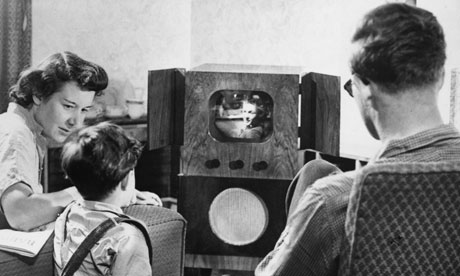
I got rid of my TV this week. Not the physical object, which stands blank-faced and dusty in a corner of my apartment, but the package from Time Warner Cable. I haven't watched TV on TV for six months. I can't make head nor tail of my cable bills. All I know is, I'm paying about $2,000 a year to watch the Oscars and repeats on the Food Network. Something had to be done.
It was a practical and cost-saving decision, but there was something emotionally fraught about making it. Twentysomethings presumably don't have this, but I'm 37 and still basically wired for a one-screen existence. You can have a million devices; you can use them simultaneously while watching TV; you can even get most of your content from YouTube or Hulu. (And you do. Apart from live sporting events, everything you watch via your cable provider can be found, as we know, online.)
But the fact remains, you can't just not have a telly. What if something happens? What if the next 9/11 or Diana's death comes around, and you're left scrambling for adequate livestreaming? How will today's kids bond with each other in the first week of college without the Crap TV of Our Youth conversation, which the on-demand model more or less rules out? (By this I mean, if I'd actually had to choose and download what I saw when I was growing up, rather than channel-surfing and idly dropping in on bad telly, I would never have watched Crossroads, Central Weekend Live or anything with Keith Chegwin in it, and those references, or their US equivalent, are crucial when you're bonding at university freshers' week).
It's just nostalgia, I know. When something really bad happens, consuming the filler of rolling cable news is an emotional response that will find expression through other modes and delivery systems. And, of course, you can stream content onto your TV set and watch it in exactly the same way.
But the fact that it's not a universal is what changes the experience. Like the price of a Big Mac, for a long time, how you watched TV was a variable you could index across all other categories. When I was growing up, what kind of TV you had and how it was policed were crucial litmus tests for how weird your parents were. For example, you could still have a black-and-white telly in the mid 1980s, but it had to be your auxiliary set, in the spare room upstairs, or, if you were really rich, in the kitchen on the counter.
There was the kid at school who was bullied for not having a telly thanks to her weird parents, and the other kid, who had a telly, but whose even weirder parents would only let her watch the BBC, because ITV was "too violent". (That was the least of her problems. They also dressed her in yellow flared trousers on non-uniform day – this was in 1986 – and her dad asked a ridiculous question at the parents' meeting prior to the school trip to France. Something about alcohol. I still remember, with a pang, how she hung her head in shame.)
There are modern iterations of this, of course: how much time children are allowed to spend online, and whether their parents let them have a computer in their room or insist on keeping it in the kitchen, where they can look over their kids' shoulders as they pass. (When I was growing up, those of my peers who had a TV in their bedrooms were thought to come from recklessly liberal households.)
And all new technology invites complaint: television once heralded the death of the family, with that apocalyptic vision of people staring slack-jawed at the screen, trays of boil-in-the-bag food on their knees, unexpressed opinions about the world turning to dust in their brains. It was probably the same with radio. It was probably the same when they ditched oral history for Gutenberg's dangerous new print medium, and so it goes on.
Now, with each member of the household plugged into his or her device, oblivious to the world around them, the advent of TV looks like a golden age of family togetherness. At least, when you watch TV together, you can comment to each other on what you're all seeing. And while, thanks to second-screen activity, we probably interact more than we ever did with each other while watching – according to this survey around half of us use a device to chat to others while a show is airing – they're not in the room with us.
Speaking of which, how do you even arrange the room when there's no TV as focal point? Where are you supposed to point the sofas?
The only lesson of this, apart from the fact that we should all have bought Netflix stock two years ago, is that you cling to what you know. These cultural touchstones and where they fall in our lives define us by generation.
And so, while I got my head around not having a landline some time ago, saying goodbye to the TV is a bigger deal. When I think of TV as it was, I think of those Wimbledon finals of the 1980s, the Muppet show on Sunday night, Charles and Di's wedding. The lack of choice in British telly 30 years ago was such that everyone was watching the same thing at the same time, and there is something to be said for that.
One day soon, I'll bite the bullet and ditch the hulking great Sony in the corner of my living room, and that will be the end of that. But not yet.

